Glossier is one of the direct to consumer beauty brands that are challenging the established beauty conglomerates.
And it seems that their minimalist look and close collaboration with their customers is irresistible for millennials.
Most profile pieces on the company (with a little help of its own PR department) makes it seem that customers emerge out of thin air.
But below the surface, a lot more is happening, including a good bit of Google Ads.
Let’s dig in!
Table of Contents
The Glossier Origin Story
Glossier originated a lifestyle and beauty blog that founder Emily Weiss started in 2010 while she was working at Vogue. The site grew fast (up to 10M page views/mo) and enabled Weiss to look beyond the straightforward advertising opportunities.
Being at the crossroads of big audience actual consumers and industry contacts, she had a good feeling of the opportunities in that market. So in 2014, she managed to raise $2 million in venture capital to start Glossier.
The first version of the company was a small product catalog of only 4 SKUs. Its biggest selling point was the vision of beauty that resonated with a lot of (young) women. Make women feel good. Instead of telling them that they aren’t enough.
They did that by staying close to that core audience to help them develop products and get feedback.
That worked and the company has been growing since.
The Business of Glossier
To fund its expansion, Glossier has raised a total of $186M to date, valuing the company at $1.2billion.
A pretty big amount. To put that number in perspective, the company made $100 million in revenue in 2018.
The investment has been used to expand its product line, develop its platform, expand internationally, and open up two physical retail locations.
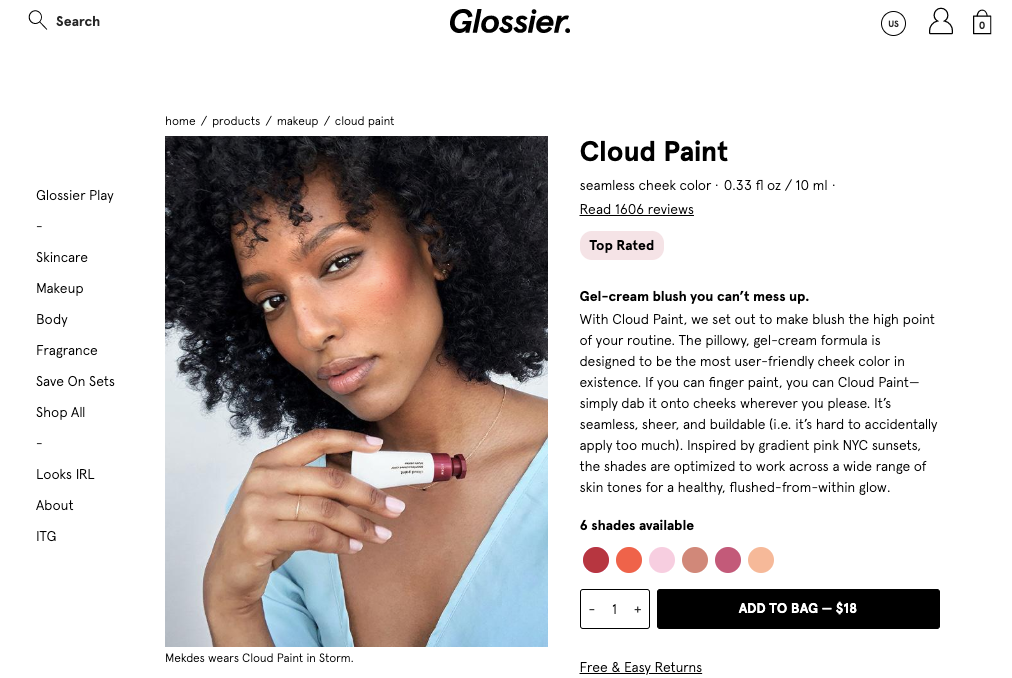
Cloud Paint, one of Glossier’s most popular products
That product development part shouldn’t be underestimated. In some interviews, the Glossier team claims to have spent 2 years creating their sunscreen product
The reason behind this focus is to get every part of the product right.
They use the millennial version of Amazon’s Press Release product launch process:
“If this were an Instagram post, what would the comments be?”
Since launching their product catalog has expanded and now consists of 54 products, some under a brand extension, called Glossier Play.
Glossier.com Traffic Analysis
Glossier doesn’t sell on other platforms, so most of that $100M revenue comes through its own website.
So with the help of Similarweb, we can get a closer look at where they get their traffic.
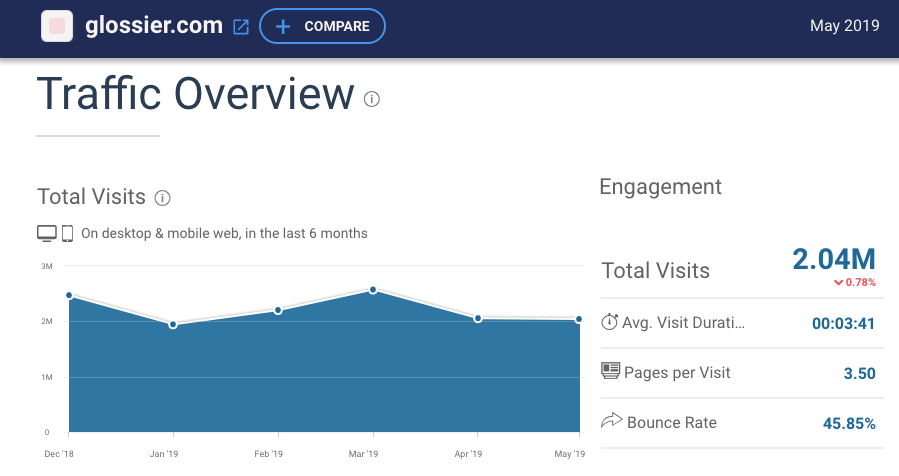
Traffic overview for glossier.com – source: Similarweb
In June 2019, they got about 2M visits.
The bulk of the traffic comes direct (44%) and via search (39%).
While the brand is very strong on Instagram, only 9% of traffic is attributed to social.
That percentage probably isn’t accurate, I bet a lot of the Instagram traffic is categorized as direct traffic. Which can also be the case for a lot of advertising campaigns they run.
The search traffic breaks down to 85% organic search and 15 paid search (117,000 visitors)
Referrals account for 4% of traffic. Mostly coming from intothegloss.com, the original blog from which the company sprouted. That site accounts for 32,000 visits a month, so its a pretty vital part of their content strategy.
Another 15% comes from Buzzfeed, that’s promoting Glossier via an affiliate deal.
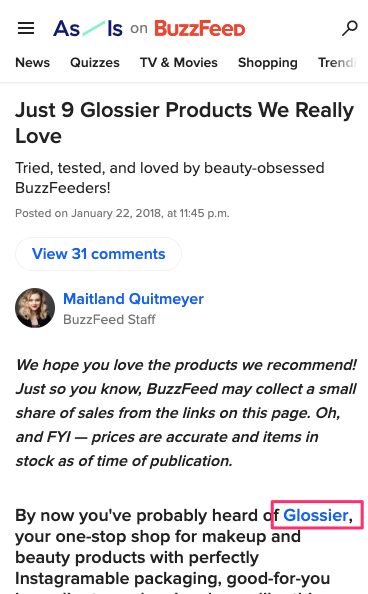
Glossier affiliate link in a Buzzfeed article
Next, are email and display, each picking up 1.5% of the traffic.
From this breakdown, and from the PR efforts from Glossier, it might seem like sales appear out of thin air.
Not to take any credit away from the great brand and community they’ve built, but Glossier also spends a good amount on ads. Mostly Instagram and Facebook ads but I even saw some experiments with Reddit ads.
How much? I don’t know, I’m the Google Ads expert, not Facebook Ads 😎
So in the next section, I’ll tell you exactly how much they spend to get 117,000 visits to their site via paid search!
Glossier Google Ads Campaigns
Here is an overview of what Glossier spent on Google Ads during June 2019:
| Ad Spend | Clicks | CPC | |
| Search Ads | $40,700 | 64,900 | $0.63 |
| Shopping Ads | $44,285 | 52,100 | $0.85 |
| YouTube Ads | $0 | 0 | $0 |
| Display Ads | $0 | 0 | $0 |
| TOTAL | $84,985 | 117,000 | $0.73 |
Source of these numbers is Semrush, Spyfu, Similarweb and my own ecommerce benchmarks collection.
Now let’s take a closer look at the different parts of their strategy.
Google Search Ads
Looking in from the outside, Google Ads are often kind of a black box.
But thanks to some detective work, we can take a look behind the scenes of the Glossier Google Ads account structure 🤓
Here is what that looks like for the Search Ads:
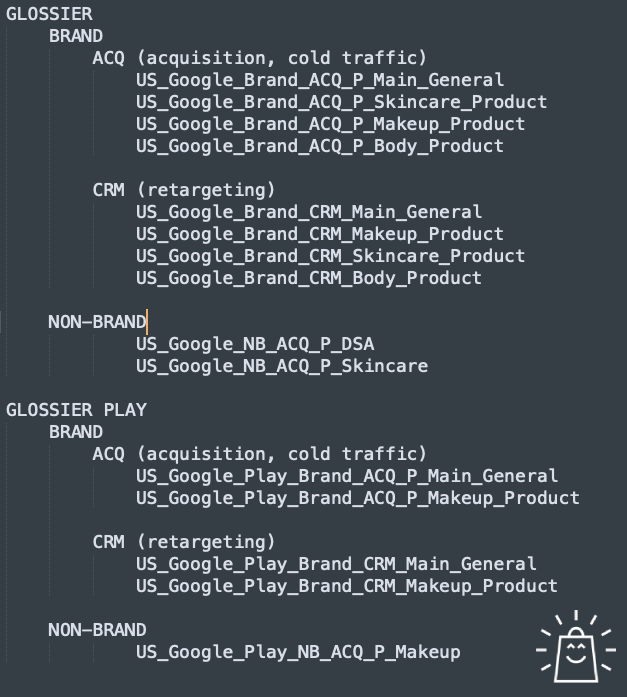
Glossier Google Ads Search campaigns structure
On the highest level, there are campaigns for each of the brands: Glossier and Glossier Play.
One level deeper the campaigns are split intro branded and non-branded campaigns.
Then those groups are split into ACQ & CRM. That might sound a bit cryptic but here is what it means:
- ACQ: campaigns focused on acquisition. These target people that haven’t interacted with the website before.
- CRM: these campaigns target people that have been to the website. This is the RLSA (remarketing lists for search ads) feature in Google Ads. The name CRM probably means that they have a ton of different audiences in this campaign. One will be different kinds of website visitors (Product viewers, shopping cart abandoners, etc). But they could also sync their email lists (website signups, past customers, high-value customers) with Google Ads. That allows them to increase the bids for people that are most valuable to them.
So the ACQ & CRM campaigns are exact copies, except for the audiences they target.
Glossier also runs campaigns outside the United States: in the United Kingdom, Canada & France.
The campaign structure in those countries seems to be a copy of the US ones. Here is what the ACQ campaigns for the UK look like:
- UK_Google_Brand_ACQ_P_Main_General
- UK_Google_Brand_ACQ_P_Skincare_Product
- UK_Google_Brand_ACQ_P_Makeup_Product
- UK_Google_Brand_ACQ_P_Body_Product
Branded paid search
Looking closer at those branded campaigns, we can see a campaign for the core brand keywords (“glossier”) and a couple of others that are split according to the category (Skincare, Body & Makeup).
This resembles the site structure pretty well, which often is a good approach:
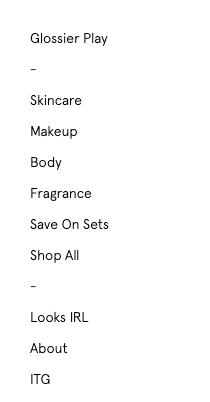
glossier.com website navigation
Branded paid search accounts for 80%, while non-branded traffic brings in 20% of the visits.
Top 10 branded keywords
| Keyword | Monthly searches | CPC | Clicks |
| glossier | 368,000 | $0.18 | 17,296 |
| glossier promo code | 40,500 | $1.12 | 1,903 |
| glossier boy brow | 14,800 | $0.31 | 695 |
| glossier lip gloss | 14,800 | $1.87 | 695 |
| glossier play | 8,100 | $0.81 | 380 |
| glossier nyc | 8,100 | $1.94 | 380 |
| glossier solution | 6,600 | $0.43 | 310 |
| glossier cloud paint | 6,600 | $0.3 | 310 |
| where to buy glossier | 6,600 | $1.42 | 310 |
| glossier store | 6,600 | $2.36 | 310 |
Source: SEMrush
No surprises in this list. The core brand name is searched for the most.
There are a ton of promo code searches, which they try to capture by offering a 10% off on the landing page.
Another big part of the top 10 are the product and subbrand search queries boy brow, lip gloss, solution, play, cloud paint.
This list also shows the impact that a product name can have on the cost per click:
- “Glossier cloud paint” – does not include the generic category description (blush) – CPC: $0.31
- “Glossier lip gloss” – does include the generic category description – CPC: $1.87
A 6x difference in cost per click!
This is not the most important reason to come up with unique product names though.
Having an SEO friendly product name (meaning it includes queries that people look for) can help you rank organically:
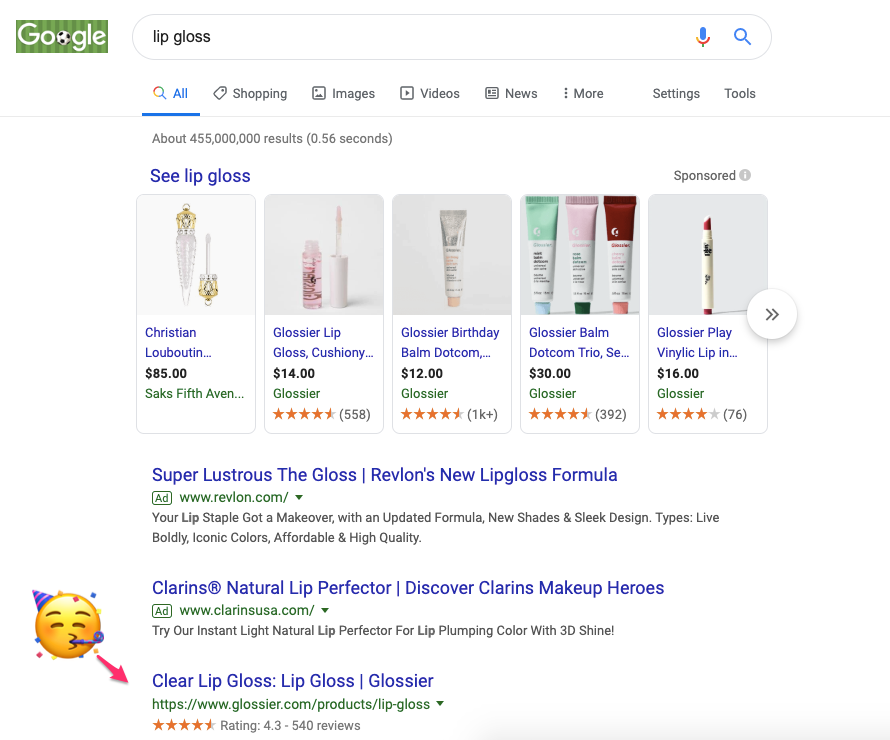
Glossier ranks first for “lip gloss
Search Advertisements
The Glossier text ads are simple and to the point:
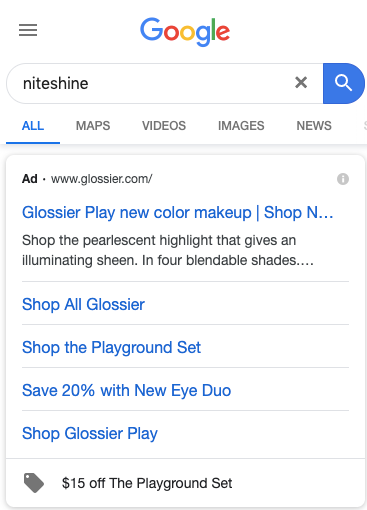
Example of a promotion extension
They’re focused on the brand’s main selling points: Skin first, Makeup second, beauty in real life, etc.
Their ad extensions are also pretty solid.
In the callout extensions, they mention a couple of other benefits: Free shipping over $30, Free returns, 100% not animal tested, etc.
One valuable thing they are doing is using their sitelink extensions to push a newly released product: the Brow Flick.
A second sitelink: “Shop the Iconic Brow Duo” actually points people to a combo of that newly released product.
That speed and control is an advantage over the organic sitelinks that sometimes appear.
They’re also pushing 10% Off First Order in their sitelinks. This points people to the regular products category page, but it shows kind of a notification in the top right corner of the page. Pretty smart
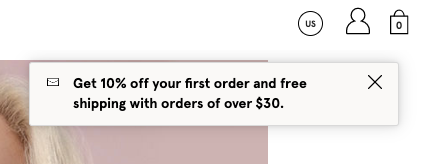
10% off notification on Glossier.com
Glossier also uses promotion extension to push sets of products. This is a pretty smart way of discounting.
Glossier also runs ads in France. Here is what that looks like:
The first thing that jumps out is the language, the ad is in English while my browser settings were in French.
One of the Headline texts points out that they are now “Now shipping to France”.
This is a pretty small tweak compared to translating and managing campaigns in another language.
But before you rush to copy this, this will only work in very few cases. A different language will alienate most people that see the ad. I usually see very low click-through rates on these ads, with a quality score punishment as a result.
But in the case of Glossier, their ads seem to be limited to brand and product name searches. So since consumers can only get -Glossier products from glossier.com, they have no other option.
Landing pages
Most of the paid traffic lands on the homepage or specific product pages.
They’ve clearly invested a lot in the site because the overall experience is very nice. It looks and feels great, the essential product info is there (what’s inside, how to use it, etc) there are a lot of genuine reviews.
I can see people spending a lot of time on the site and it converting pretty well.
Non-branded paid search
The structure of the non-branded campaigns is a lot more straightforward. No specific RLSA campaigns. Only a campaign focused on non-branded queries related to skincare, and a dynamic search ads (DSA) campaign to cover the rest of the catalog.
Top 10 unbranded keywords (sorted by traffic they bring to glossier.com)
| Keyword | Monthly searches | CPC | Clicks |
| Highlighter makeup | 18,100 | $2.95 | 850 |
| Boy brow | 12,100 | $0.37 | 568 |
| Eau de parfum | 9,900 | $2.10 | 465 |
| Clear lip gloss | 9,900 | $1.56 | 465 |
| Cloud paint | 6,600 | $0.67 | 310 |
| Liquid lipstick | 5,400 | $1.98 | 253 |
| Best Highlighter | 14,800 | $1.98 | 192 |
| face highlighter | 3,600 | $2.06 | 169 |
| kat von d liquid lipstick | 3,600 | $1.66 | 169 |
| anastasia liquid lipstick | 3,600 | $0.46 | 169 |
Source: SEMrush
The first thing that comes to mind by looking at this top 10 is how few clicks those top search queries bring in.
That’s in-line with the total amount of non-branded paid search traffic, about 12,000 visitors/mo. That’s pretty common. These clicks cost around $2, which is very hard to run profitably on $35 orders. In the teardown of Away Travel we say that they WERE able to make it work. But that’s because their market share was a lot stronger and they have a 10x AOV.
The second remark about this top 10 is the strength of product names like “boy brow” and “cloud paint”. That indicates that there is strong brand awareness around these Glossier products.
Lastly, there are also a couple of search queries that are on this list that might not be ideal: kat von d & anastasia liquid lipstick.
Both are search queries for competitive products. Sometimes it’s interesting to keep them in the campaign, or even target them with specific competitor focused campaigns. But seeing at how little they spend on non-branded search, I’m not sure if this is intentional.
I would recommend them to go through their search terms report and look for search queries to add as negative keywords instead and check the match types of their current keywords.
Search Ads
The non-branded search ads are an interesting example of how to link the generic search queries to your product names.
Here is the ad that pops up for a search for “eye pencil”:
They use the Headline 1 to intro Glossier Play, their “color makeup” brand. Then only in Headline 2 they mention the eye pencil search query and link it to “Colorslide”, the actual product name.
The ad itself is written specifically for this product and contains some extra features and benefits.
Also notice how the display URL is “minimal”, without any paths being defined. (An alternative would be www.glossier.com/Makeup/Eye-Pencil )
The same is happening with a search for “eau de parfum”:
Glossier You is the product name of their perfume. The rest of the ad is pretty generic, which indicates its served from a catch-all DSA campaign.
This catch-all campaign is great to start and quickly get ads up for all of your products without spending too much time.
But as we cover in our course, revisiting this campaign and rewriting ads specific for these search queries can further improve the results. CTR will go up and quality score will often follow.
Ad extensions are leveraged pretty well, same as for the branded search campaigns.
Glossier Shopping Ads
Before we get to the details of what Glossier is doing with its Shopping Ads, I want to show you something they are NOT doing.
The above screenshot shows a search for “glossier lip gloss” but as you can see, Glossier doesn’t show in that top ad carousel. That’s because they are not running Showcase shopping ads.
So instead, MAC Cosmetics is the first result/ad that searchers encounter. This is costing Glossier clicks and sales.
The same is happening in the UK:
Glossier isn’t the only top ecommerce brand that is missing out on Showcase Ads, I mentioned the exact same thing in our teardown of Away Travel.
Glossier Shopping Campaign structure
Here is the Google Shopping campaign structure:
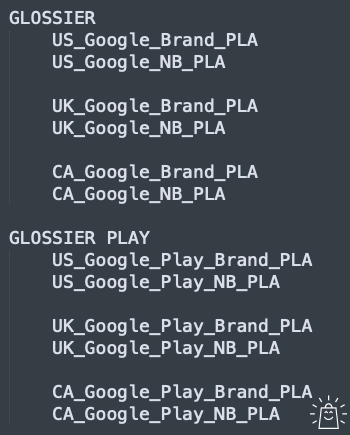
Glossier Google Shopping campaign structure
This campaign structure is a lot simpler compared to the branded search campaigns.
Two sets of campaigns one for Glossier and one for Glossier Play. These are further subdivided separating branded and unbranded (NB) search queries.
Then each country has its own specific campaigns: US, UK & CA.
Multiple countries
Expanding Google Shopping to other countries that speak the same language is pretty easy. Especially since Glossier actually has local currencies on its website (and in their product feed).
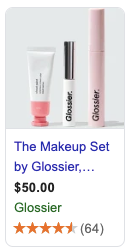
This makeup set is $50 CAD or about $40 USD.
But as Glossier starts selling in regions with different languages, new issues pop up.
With the Search ads campaigns, they (and you) can get away with showing an English ad to a French-speaking audience.
But Google Shopping requires the landing page to be in the language that you are targeting with your ads.
So a Shopping campaign targeting French-speaking people in France needs to have the ad + landing page in French.
They’ve translated some parts of their website, mainly checkout related, but the product content is still all English.
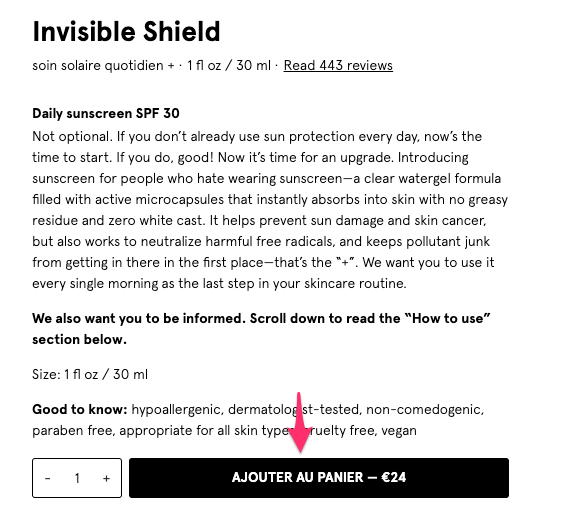
Add to cart button translated to French
Being from 🇪🇺 Europe, I have a lot of experience with the complexity that multiple languages bring. Translating a website quickly adds dependencies and often brings technical challenges as well.
Missing RLSA campaigns
The biggest distinction with the Search campaigns is that there are no dedicated campaigns for Remarketing audiences. They’ve probably added these Audiences to the actual campaigns, so they can target these visitors or customers like that.
But Shopping traffic almost brings in the same amount of clicks than the Search campaigns, so I’d be interested to hear the reason why they do split up the search campaigns into RLSA and non-RLSA, but they don’t do that for SHopping campaigns.
Campaign naming conventions
Also notice how the PLA in the campaign name indicates these are Shopping campaigns, this is pretty useful when filtering campaigns in either Google Ads or analytics. (In case you’re wondering PLA stands for product listing ads, the old name for Shopping Ads)
Ad group structure
If I speculate on the deeper account structure, I’d say they further subdivide these campaigns into ad groups based on the different product types:
- Lip gloss
- Cloud paint
- Brow boy
- Etc.
Top Shopping keywords
| Keyword | Monthly searches |
| wunderbrow | 22,200 |
| setting powder | 22,200 |
| glow recipe | 18,100 |
| glitter eyeshadow | 14,800 |
| makeup set | 14,800 |
| boy brow | 12,100 |
Source: SEMrush
From this (short) list, we can already spot quite a few differences with the Search Ads.
First of all the brand doesn’t show up, despite getting 365,000 searches a month. The simplest reason for that can be that the Shopping ads simply don’t often appear on that search query.
While the Search ads appear for products like highlighters, lip gloss, and eau de parfum. The products that show up in Shopping are quite different: setting powder, glow, glitter, makeup set.
The only consistent one is the boy brow, that’s also one of the top search queries for the Search Ads.
The top search query in the list is “wunderbrow”, a competitor product. Interesting that they get so much visibility on that via Shopping, while it doesn’t appear at all in their search campaigns.
This might be an indicator that their targeting is a bit too wide and that there might be some keywords slipping through.
Another thing I found during my research is that search queries like “niteshine” and “vinylic lip”, both product names were served from the Non Brand campaign.
These two findings indicate to me that they could further optimize their campaigns and move from a 2 to a 3 tier campaign structure.
Existing structure:
- US_Google_Play_B_PLA: targets search queries for glossier
- US_Google_Play_NB_PLA: all other queries
New structure:
- US_Google_Play_B_PLA: targets search queries for glossier + product names
- US_Google_Play_COMP_PLA: targets competitor brands/products
- US_Google_Play_NB_PLA: all other queries
This can help them to tune their bid strategy to the actual value that they are deriving from these search queries.
YouTube Video Ads
The view counts on the videos on their YouTube channel are pretty low, with a few exceptions.
That’s usually a good indicator that they haven’t done a lot with YouTube Ads.
At least not something publicly, it could be that they’ve experimented with campaigns in the past. But today, their video dollars are probably better spent on Instagram.
Some of their social traffic does show some YouTube referrals, but that is more thanks to the many reviews they get from other people.
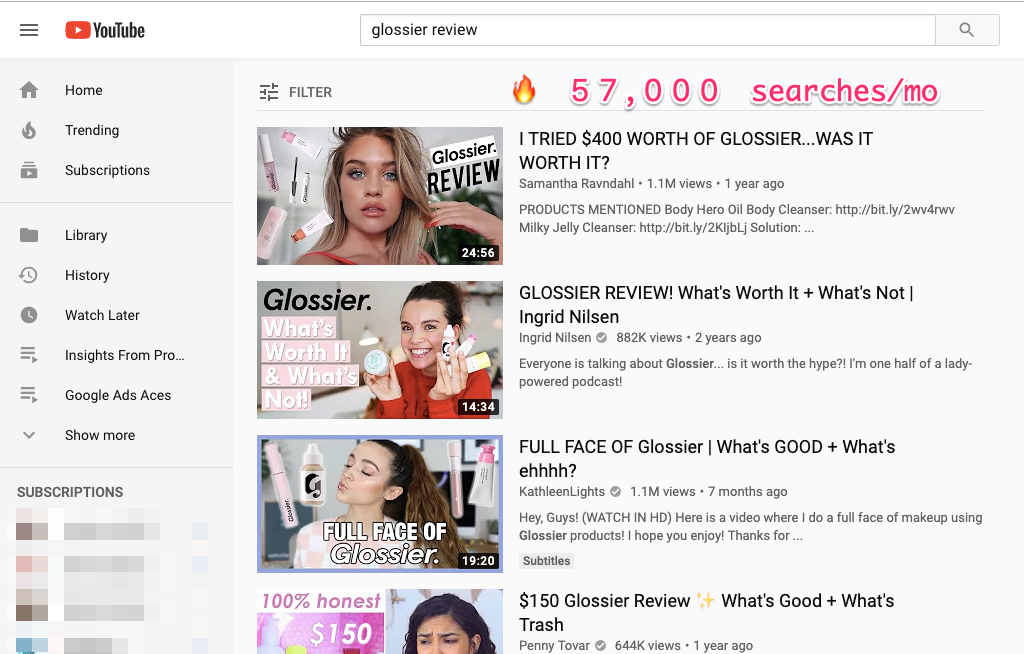
Search on YouTube for glossier review
Google Display Ads
Usually, it’s pretty easy to find a company’s display ads, especially if they are running remarketing campaigns.
But I wasn’t able to track down any current banners on the Google Display Network. But they have done some things in the past. Here is one of the banners that I’ve found:
So I have to disappoint you when it comes to their current display ads strategy. But I did find some remnants of older campaigns that might offer some clues to their approach 🙂
Here are some of the names of the campaigns that I’ve found:
- US_Google_Display_ACQ_RTG_Generation
- US_Google_Display_ACQ_P_Geng_Customintent
From what we’ve learned from the Search campaigns, the ACQ indicates that these target people that haven’t been to the site.
Both campaigns are for a specific Glossier lipstick, Generation G. It was relaunched late 2018, so I assume that they were using display ads to support that launch.
The Customintent at the end of that second campaign indicates that they are using Custom Intent, one of the targeting options on the Google Display Network:
Unlike the premade audiences that Google Ads offers, you can build your own custom intent audiences based on specific keywords or landing pages. This allows Glossier to build audiences that are interested in lipstick, not just Makeup.
💰The Glossier Scoreboard
Money time!
The Scoreboard is the part where we pull together all the research and look at how much money Glossier is making (or losing) with their Google Ads campaigns.
One thing that I usually don’t mention is the return rate. Mainly because that info isn’t often in public. But in an interview, CEO Weiss revealed that they only have a 1% return rate. Which is very low for a company that offers free returns.
Gross margin
Research firm Euromonitor revealed a 75% margin for premium cosmetics brands. Other brands have margins between 60-80%.
Like most of the brands we’ve covered in this series, Glossier sells direct to consumer, which usually gives them a little extra margin.
So I don’t think it would be an exaggeration to estimate Glossier also having 80% gross margins.
Average order value
Glossier doesn’t seem to do price promotions. Their products are relatively cheap compared to other beauty and cosmetics brands. And range between $12-$35, with the perfumes going up to $60.
They also sell a lot of combos and upsells during checkout, which all help raise the average order value.
That said, they offer free shipping on orders over $30. That makes me guesstimate that their average order value is a little bit higher, around $35.
Like always, we start The Scoreboard by filling in all the numbers and assume that the company spends all of its profits on acquiring new customers:
At a customer acquisition cost (CAC) of $28, the company makes $106,231.5 every month in revenue and $0 in profits.
That’s not very realistic, so let’s see what happens if we decrease that CAC.
Now I’ve lowered the CAC from $28 all the way to $2.8.
To continue, I pick a CAC somewhere in the middle which amounts to 50% of gross profit.
Repeat purchase rate
For the top ecommerce companies, revenue from repeat customers eclipses that of new customers.
That dynamic takes some time to build, but it seems exactly like what is happening with Glossier right now.
Because in a 2018 interview, Glossier CEO said that 50% of revenue came from repeat purchases.
That is huge and a big driver of profitability.
Here is what impact that has on the profitability of the Google Ads campaigns:
The repeat purchase moves from 0% (only one sale per customer) on the left to 50% (half of all customer purchase again) on the right.
The actual dynamics of repeat purchases are more complex but this gives a pretty good idea of the profitability.
In the pink box, I’ve picked the scenario that seems to be most likely. $85k in ad spend turns into almost $300k in revenue, a ROAS of 3.5. And it makes Glossier $156k/mo in gross profit!
That’s it for our teardown of the Glossier Google Ads campaigns!
What did you find most surprising in this analysis? Let us know in the comments!
Read our other breakdowns: Purple – MVMT – Judy – Away – Allbirds – Ritual – Caraway – FIGS
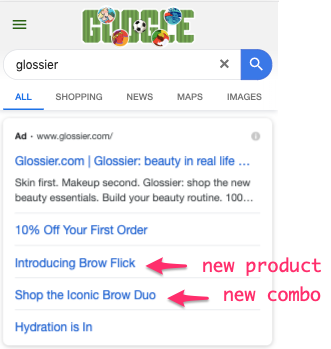
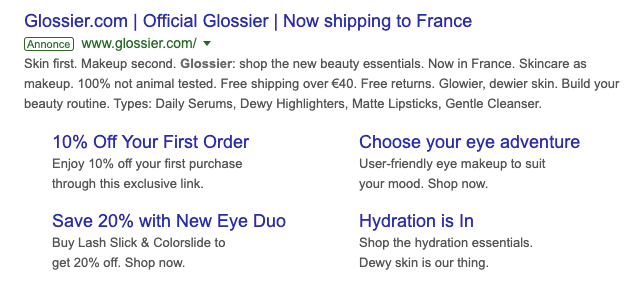

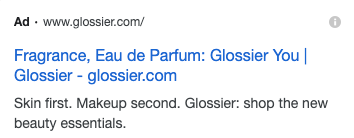
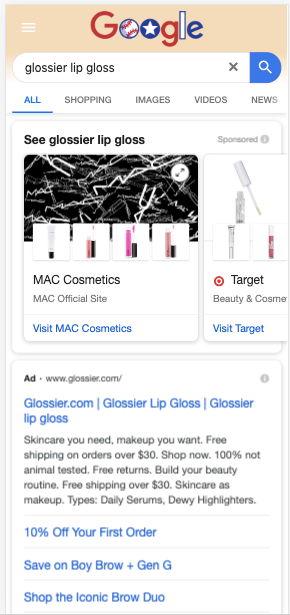
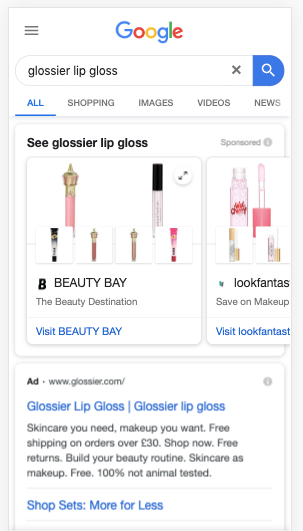
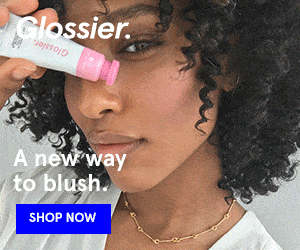
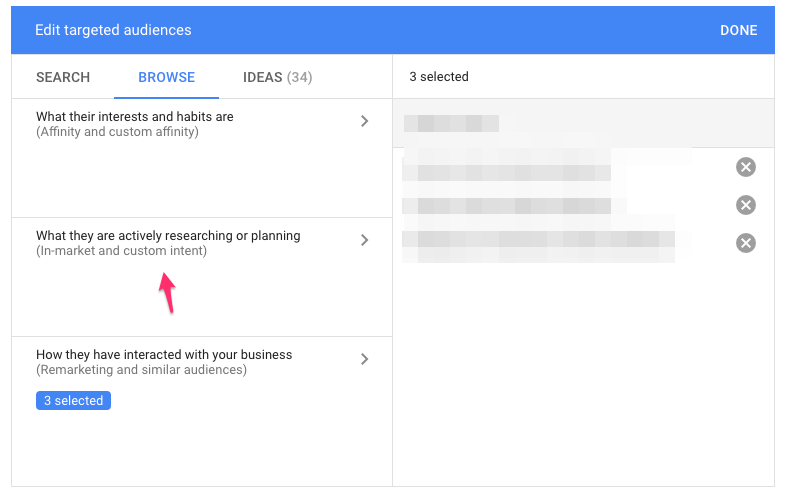
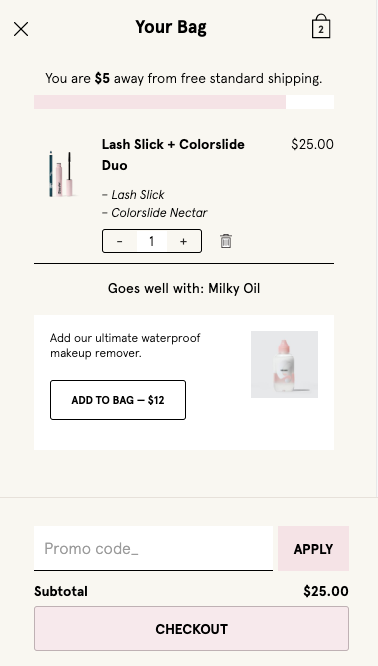
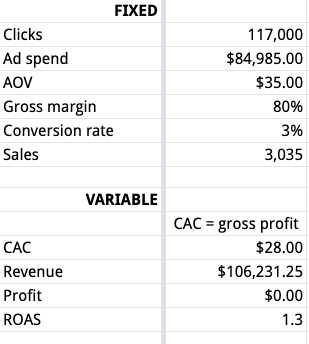

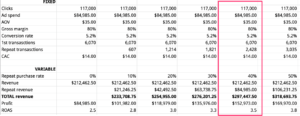

Great post!
One comment on the language requirement for landing pages and ads; this is partly true as Google has updated its policy to allow English across nearly all markets. https://support.google.com/merchants/answer/160637?hl=en
Hi Ian,
Thanks for chiming in! That policy update is interesting, makes expanding internationally with Shopping a lot easier. Looks like I need to revisit some client campaigns 🙂
-Dennis
Hi Dennis,
Amazing post — so in-depth! Just a heads up, it looks like Glossier does have showcase shopping ad[s] at least in the U.S. now.
Hi Bee,
Thanks for the update! Perhaps someone pointed them to this post 😉
Hi Dennis,
Great post!
They probably didn’t split their Shopping campaigns into RLSA and non-RLSA because you can’t exclude audiences in shopping.
Good catch KC! Glad to know you enjoyed the article 🙂
Great post Dennis. Can you share how you uncover the campaign structures?? Very interesting 🙂
Thanks Filip,
Two words: UTM parameters
😉
Haven’t known about the promotion extension. Great opportunity for pushing discounts! Will try it!
Amazing research! I really admire you for the effort you have put into this. Glossier is a huge brand as far as i know.
I appreciate the comment Sasha 🙂
Hi Dennis,
Amazing post — so in-depth! Just a heads up, Very interesting 🙂